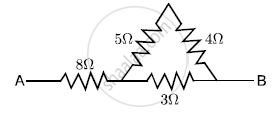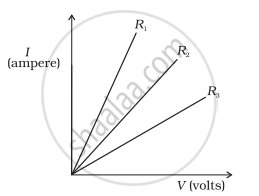Advertisements
Advertisements
Question
Let the resistance of an electrical device remain constant, while the potential difference across its two ends decreases to one fourth of its initial value. What change will occur in the current through it? State the law which helps us in solving the above stated question.
Solution
The change in the current flowing through the electrical component can be determined by Ohm's Law.
According to ohm's law i.e.,
V = IR
V: applied voltage
I: current
R: resistance
⇒ I = `"V"/"R"`
Now potential difference becomes one fourth,
V' = `"V"/4`
So current will be: I' =`(("V"//4))/"R"`
⇒ I' = `"v"/(4"R")`
⇒ I' = `"I"/4`
When the potential difference is one fourth, the current through the component also decreases to one fourth of its initial value.
RELATED QUESTIONS
The relationship between the potential difference and the current in a conductor is stated in the form of a law.
1) Name the law.
2) What does the slope of V-I graph for a conductor represent?
3) Name the material used for making the connecting wire.
The graph between V and I for a conductor is a straight line passing through the origin.
What should remain constant in a statement of this law?
Show by a diagram how two resistors R1 and R2 are joined in parallel. Obtain an expression for the total resistance of the combination.
Calculate the effective resistance across AB?

What is non-ohmic resistor?
Answer the following question.
Distinguish between Ohmic and non-ohmic substances; explain with the help of example.
State macroscopic form of Ohm’s law.
Which of the following I-V graph represents ohmic conductors?
A student carries out an experiment and plots the V-I graph of three samples of nichrome wire with resistances R1, R2 and R3 respectively. Which of the following is true?

The heat produced by a 100 w heater in 2 minute is equal to
